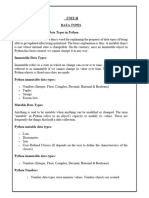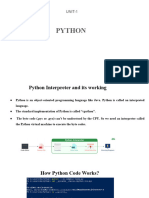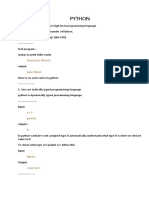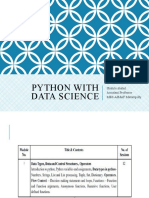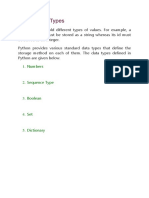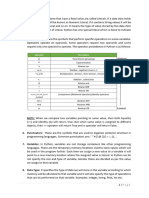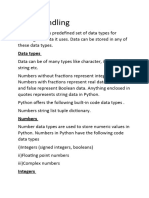0 ratings0% found this document useful (0 votes)
18 views100 pagesData Handling
The document provides an overview of Python data types, including numbers, strings, lists, tuples, and dictionaries, along with their characteristics such as mutability and immutability. It explains the differences between mutable types (like lists and dictionaries) and immutable types (like integers, floats, and strings), as well as how to access and manipulate these data types. Additionally, it covers operators in Python, including arithmetic operators and their usage in expressions.
Uploaded by
saravagawal4321Copyright
© © All Rights Reserved
We take content rights seriously. If you suspect this is your content, claim it here.
Available Formats
Download as PDF or read online on Scribd
0 ratings0% found this document useful (0 votes)
18 views100 pagesData Handling
The document provides an overview of Python data types, including numbers, strings, lists, tuples, and dictionaries, along with their characteristics such as mutability and immutability. It explains the differences between mutable types (like lists and dictionaries) and immutable types (like integers, floats, and strings), as well as how to access and manipulate these data types. Additionally, it covers operators in Python, including arithmetic operators and their usage in expressions.
Uploaded by
saravagawal4321Copyright
© © All Rights Reserved
We take content rights seriously. If you suspect this is your content, claim it here.
Available Formats
Download as PDF or read online on Scribd
You are on page 1/ 100
tor more Updates VISIT: WWW. PASS
LEARNING OUTCOMES :
Q DATA TYPES
Q OPERATORS
Q MUTABLE AND IMMUTABLE TYPES
Q EXPRESSION
tor more updates visit: www.python4csip.com
DATA TYPES
Data type in Python specifies the type of data we are going to store in any
variable, the amount of memory it will take and type of operation we can
perform on a variable. Data can be of many types e.g. character, integer,
real, string etc.
Python supports following data types:
> Numbers (int, float, complex)
> String
> List
> Tuple
> Dictionary
tor more updates visit: www.python4csip.com
NUMBERS
From the name it is very clear the Number data types are used to store numeric
values. Numbers in Python can be of following types:
(i) Integers
a) _ Integers(signed)
b) Booleans
(ii) Floating point numbers
(iii) Complex Numbers
tor more updates visit: www.python4csip.com
INTEGERS
Integers allows to store whole numbers only and there is no fraction parts.
Integers can be positive and negative e.g. 100, 250, -12, +50
There are two integers in Python:
1) Integers(signed) : it is normal integer representation of whole numbers.
Integers in python can be on any length, it is only limited by memory
available. In Python 3.x int data type can be used to store big or small
integer value whether it is +ve or -ve.
2) Booleans: it allows to store only two values True and False. The internal
value of boolean value True and False is 1 and 0 resp. We can get
boolean value from 0 and 1 using bool() function.
tor more updates visit: www.python4csip.com
INTEGERS
>>>bool(1)
True
>>int(False)
0
>>>str(False)
‘False’ # str() function is used to convert argument to string type.
tor more updates visit: www.python4csip.com
FLOATING POINT NUMBERS
It allows to store numbers with decimal points. For e.g. 2.14. The decimal point
indicate that it is not an integer but a float value. 100 is an integer but 100.5
is a float value. In Previous chapter we have already discussed float values
can be of type type:
1. Fractional Form : 200.50, 0.78, -12.787
2. Exponent Form : it is represented with mantissa and exponent. For e.g
>>>x = 1.5E2 # means 1.5 x 10? which is 150
>>>print(x) # 150.0
>>>y=12.78654E04
>>>print(y) # 127865.4
tor more updates visit: www.python4csip.com
FLOATING POINT NUMBERS
Floating point number are mainly used for storing values like distance, area,
temperature etc. which have a fractional part.
Floating point numbers have two advantage over integers:
v they can represent values between the integers
v they can represent a much greater range of values
But floating point numbers suffers from one disadvantage also:
¥ Floating point operations are usually slower than integer operations.
In Python floating point numbers represent machine level double
precision floating point numbers i.e. 15 digit precision.
tor more updates visit: www.python4csip.com
COMPLEX NUMBERS
Python represent complex numbers in the form A+B). To represent imaginary
numbers, Python uses j or J in place of i. So in Python j = V—1. Both real
and imaginary parts are of type float
eg.
a=0+6j
b=25+3J
>oraad+5j
>>>print(a) # (4+5))
>>>b=0+2j
>>>b #(2)
tor more updates visit: www.python4csip.com
COMPLEX NUMBERS
Python allows to retrieve real and imaginary part of complex number using
attributes: real and imag
If the complex number is a then we can write a.real or a.imag
Example
>>>a=1+3.54)
>>>print(a.real) #1.0
>>>print(a.imag) # 3.54
tor more updates visit: www.python4csip.com
STRING
In previous chapter we have already discussed about string. Let us recall the
things:
1. String is a collection of any valid characters in a quotation marks (‘ or“ )
2. Each character of String in Python is a Unicode character
3. Strings are used to store information like name, address, descriptions. Etc
For example:
“hello”, ‘welcome’, “sales2018", “python@kvoef.com”
tor more updates visit: www.python4csip.com
STRING
In Python string is a sequence of characters and each character can be
individually access using index. From beginning the first character in String
is at index 0 and last will be at len-1. From backward direction last
character will be at index -1 and first character will be at—len.
Dente Ta sass)
message W E L c Oo M E
tor more updates visit: www.python4csip.com
STRING
To access individual character of String (Slicing). we can use the syntax:
StringName[index position]
>>>stream="Science”
>>>print(stream0])
S
>>>print(stream|3})
e
>>>print(stream|-1])
e
tor more updates visit: www.python4csip.com
STRING
What will be the output:
>>>stream="Science”
>>>print(stream|[5]) #Output 1
>>>print(stream|-4]) #Output 2
>>>print(stream|-len(stream)]) #Output 3
(
>>>print(stream|8}) #Output 4
tor more updates visit: www.python4csip.com
STRING
We cannot change the individual letters of string by assignment because string
in python is immutable and hence if we try to do this, Python will raise an
error “object does not support Item assignment”
>>>name[1]=77 # error
However we can assign string to another string. For e.g
>>>name="Ronaldo”
>>>name="Bekham” # no error
tor more updates visit: www.python4csip.com
LISTS AND TUPLES
Lists and Tuples are compound data types i.e. they allows to store multiple
values under one name of different data types.
The main difference between Lists and Tuples is List can be
changed/modified i.e. mutable type whereas Tuples cannot be changes
or modified i.e. immutable type.
Let us take this with example:
Lists: A list in python represents a list of comma-separated values of any
data type between square brackets.
[a’’e’’o'/'/u']
tor more updates visit: www.python4csip.com
EXAMPLES - LIST
>>> family=["Mom","Dad","Sis","Bro"]
>>> family
[Mom', 'Dad', 'Sis', 'Bro']
>>> print(family)
[Mom’, ‘Dad’, ‘Sis’, 'Bro’]
>>> Employee=["E001","Naman",50000, 10.5]
>>> Employee
[E001', 'Naman’, 50000, 10.5]
>>> print(Employee)
[E001', 'Naman', 50000, 10.5]
tor more updates visit: www.python4csip.com
EXAMPLES - LIST
The values stored in List are internally numbered from 0 onwards. i.e. first element
will be at position 0 and second will be at 1 and so on.
>>> Employee=["E001","Naman",50000, 10.5]
>>> print(Employee[1})
Naman
>>> Employee[2]=75000
>>> print(Employee)
['E001', 'Naman', 75000, 10.5]
You can check the number of items in list using len() function
>>> print(len(Employee))
4
tor more updates visit: www.python4csip.com
TUPLES
Tuples as those list which cannot be changed i.e. not modifiable. Tuples are
defined inside parenthesis and values separated by comma
Example:
>>> favorites=("Blue","Cricket’,"Gajar Ka Halwa")
>>> student=(1,"Aman",97.5)
>>> print(favorites)
(‘Blue’, ‘Cricket’, 'Gajar Ka Halwa’)
>>> print(student)
(1, ‘Aman’, 97.5)
tor more updates visit: www.python4csip.com
TUPLES
Like List, Tuples values are also internally numbered from 0 and so on.
>>> print(favorites[1])
Cricket
>>> print(student[2])
97.5
>>> student[2]=99.
>>> student[2]=99 # Error, tuple does not support assignment i.e. immutable
tor more updates visit: www.python4csip.com
DICTIONARY
Dictionary is another feature of Python. It is an unordered set of comma separated
key-value pairs. Dictionary Items are defined in Curly Brackets { }
Keys defined in Dictionary cannot be same i.e. no two keys can be same.
>>> student={Roll':1,'Name':"Jagga",'Per':91.5}
>>>print(student)
>>> print(student[Per’])
91.5
>>> val=(1:100,2:300,4:900} # Key name can be string / numeric
>>> print(val(1])
100
Dictionary is mutable. i.e. We can modify dictionary elements.
>>>vall2]=1000
>>>print(val) # {1: 100, 2: 1000, 4: 900}
tor more updates visit: www.python4csip.com
DATA TYPE SUMMARY
redone
tor more updates visit: www.python4csip.com
MUTABLE AND IMMUTABLE TYPES
Python data object can be broadly categorized into two types - mutable and immutable
types. In simple words changeable/modifiable and non-modifiable types.
1. Immutable types: are those that can never change their value in place. In python
following types are immutable: integers, float, Boolean, strings, tuples
Sample Code:
a=10
b=a
c=15 # will give output 10,10,30
a=20
b=40 could be changed effortlessly, but this is not the case. Let
c=b n cl
From this code, you can say the value of integer a, b,c
tor more updates visit: www.python4csip.com
IMMUTABLE TYPES
Note: In python each value in memory is assigned a memory address. So each time
a new variable is pointing to that value they will be assigned the same address
and no new memory allocation. Let us understand the case.
>>> print(id(a))
SO)
Python provides id() function to get the >>> print(id(c))
memory address to which value /variable is progr)
refers f Caer rer sary
ba
tor more updates visit: www.python4csip.com
IMMUTABLE TYPES
Now let us understand the changes done to variable a, b,c
>>> print(id(a))
BN ESTCUUYL IO}
>>> print(id(b))
>>> print(id(c))
Python provides id() function to get the
memory address to which value /variable is
pfening E
ba
tor more updates visit: www.python4csip.com
IMMUTABLE TYPES
From the previous code it is clear that variable names are stored references to a
value-object. Each time we change the value the variable’s reference memory
address changes. So it will not store new value in same memory location that's
why Integer, float, Booleans, strings and tuples are immutable.
Variables (of certain type) are NOT LIKE storage containers i.e. with fixed
memory address where value changes every time. Hence they are
immutable
tor more updates visit: www.python4csip.com
MUTABLE TYPE
Mutable means in same memory address, new value can be stored as and when it
is required. Python provides following mutable types:
1. Lists
2. Dictionaries
3. Sets
Examples: (using
>>> employee=["E001","Rama","Sales",67000]
SRA
CRU CR RTC
>>> print(id(employee)) Ones:
71593896 ———___ i cd
>>> employee[3]=75000 eee)
>>> print(id(employee)) _ lu
71593896 «——
>>>
tor more updates visit: www.python4csip.com
VARIABLE INTERNALS
Python is an object oriented language. So every thing in python is an object. An
object is any identifiable entity that have some characteristics/properties
and behavior. Like integer values are object - they hold whole numbers
only(characteristics) and they support all arithmetic operations (behavior).
Every python object has three key attributes associated with it:
1. type of object
2. value of an object
3. id of an object
tor more updates visit: www.python4csip.com
TYPE OF AN OBJECT
type of an object determines the operations that can be performed on the object.
Built-in function type() returns the type of an object
Example:
>>> a=100
>>> type(a)
>>> type(100)
>>> name="Jaques"
>>> type(name)
tor more updates visit: www.python4csip.com
VALUE OF AN OBJECT
The data items stored in the object is a value of object. The value stored in an
object is a literals. We can using print() to get the value of an object
Example:
>>> a=100
>>> print(a)
100
>>> name="Kallis”
>>> print(name)
Kallis
>>>
tor more updates visit: www.python4csip.com
ID OF AN OBJECT
It is the memory address of any object. Although id is dependent upon the
system where it is installed but in most cases it returns the memory location
of the object. Built in function id() returns the id of an object
Example:
>>> a=h
>>> id(5)
1911018608
>>> print(id(a))
1911018608
>>>
tor more updates visit: www.python4csip.com
OPERATORS
are symbol that perform specific operation when applied on variables. Take a
look at the expression: (Operator)
10 + 257~~-~>(Operands)
Above statement is an expression (combination of operator and operands)
ie. operator operates on operand. some operator requires two
operand and some requires only one operand to operate
tor more updates visit: www.pytnon4csip.com
TYPES OF OPERATORS - ARITHMETIC
Binary Operators: are those operators that require two operand to operate upon.
Following are some Binary operators:
es
Co
(aecceecorcnennna Ex anOTTTTCE
(ScEEREEEREEEEREE (ct pEEEEEEEEE
| Fer cso |
tor more updates visit: www.python4csip.com
TYPES OF OPERATORS - ARITHMETIC
Unary Operators They require only one operand to operate like unary + and -
For e.g.
>>> ash
>>> print(+a)
5
>>> print(-a)
5
>>>
tor more updates visit: www.python4csip.com
EXAMPLE - BINARY ARITHMETIC OPERATOR
>>> num1=20
>>> num2=7
>>> val = num1 % num2
>>> print(val)
6
>>> val = 2°*4
>>> print(val)
16
tor more updates visit: www.python4csip.com
EXAMPLE - BINARY ARITHMETIC OPERATOR
>>> val = num / num2
>>> print(val)
2.857142857142857
>>> val = num // num2
>>> print(val)
2
tor more updates visit: www.python4csip.com
JUST A MINUTE...
What will be the output of following code
>>> a,b,c,d = 13.2,20,50.0,49
>>> print(a/4)
>>> print(a//4)
>>> print(20**3)
>>> print(b**3)
>>> print(ci/6)
>>> print(d%5)
>>> print(d%100)
tor more updates visit: www.python4csip.com
JUST A MINUTE...
What will be the output of following code
>>> x,y=-8,-15
>>> print(x//3)
>>> print(8/-3)
->>> print(8//-3)
tor more updates visit: www.python4csip.com
JUST A MINUTE...
What will be the output of following code
>>> x,y=-8,-15
>>> print(x//3) ————________. (3s)
>>> print(8/-3)
>>> print(8//-3)
tor more updates visit: www.python4csip.com
JUST A MINUTE...
What will be the output of following code
>>> x,y=-8,-15
>>> print(x//3) ————________. (3s)
>>> print(8/-3) —__ =
>>> print(8//-3)
tor more updates visit: www.python4csip.com
JUST A MINUTE...
What will be the output of following code
>>> x,y=-8,-15
>>> print(x//3) ————__.
>>> print(8/-3) —— 7 5
->>> print(8//-3)
tor more updates visit: www.python4csip.com
JUST A MINUTE...
What will be the output of following code
par -11 1/5
per -11%5
>>> 11%-5
>>> 11//-5
tor more updates visit: www.python4csip.com
JUST A MINUTE...
What will be the output of following ci
>>-11//5 ——_. EB
per -11%5
>>> 11%-5
>>> 111-5
tor more updates visit: www.python4csip.com
JUST A MINUTE...
What will be the output of following ci
>>-11//5 ——_. EB
>e>-11 % 5 —___
>>> 11%-5
>>> 11//-5
tor more updates visit: www.python4csip.com
JUST A MINUTE...
What will be the output of following ci
>>-11//5 ——_. EB
>e>-11 % 5 —___
>> 11%-5____, 7
>>> 111-5
tor more updates visit: www.python4csip.com
JUST A MINUTE...
What will be the output of following ci
>>-11//5 ——_. EB
>e>-11 % 5 —___
>> 11%-5____, 7
per i-5
tor more updates visit: www.python4csip.com
TYPES OF OPERATORS -AUGMENTED
ASSIGNMENT OPERATORS
It perform operation with LHS and RHS and result will be assigned to LSH
Peotone Sent ncen reece kenny
RHS minus to LHS and result Ee eer el to LHS
i [ RHS muttiby toLHS and result assigned toLHS | Prue kere
meee) | LHS divided by RHS and remainder assigned to LHS | RHS and remainder assigned to LHS
Rae rancor chore
Pee eee eke) Pee
tor more updates visit: www.python4csip.com
TYPES OF OPERATORS -RELATIONAL OPERATOR
Are used to compare two values and return the result as True or False depending
upon the result of comparison
aa
Eee ee ene eer ees
Ce eee
Eee een ens een
Not equal to oe ORC UM Oe ORCL REAL
tor more updates visit: www.python4csip.com
FEW POINTS TO REMEMBER - COMPARISONS
v For numeric types, the values are compared after removing trailing zeros after
decimal point from floating point number. For example 6 and 6.0 will be treated
as equal.
¥ Capital letters (ASCII code 65-90) are considered as less than small letters
(ASCII code 97-122).
¥ >>>'Hello’<‘hello’ # will give result true
v In string be careful while comparison, because special characters are also
assigned to some ASCII code. Like ASCII code of space is 32, Enter is 13.
v >>>'Hello’ ==" Hello’ # false, because there is space before H in second string
v Like other programming language, In Python also we have to be very careful
while comparing floating value because it may gives you unexpected result.
So it is suggested not to use equality testing with floating values.
tor more updates visit: www.python4csip.com
COMPARISON WITH FLOATING VALUES
>>> 0.1+0.1+0.1==0.3
Will return False
How?
Let us check the value of 0.1+0.1+0.1
>>>print(0.1+0.140.1)
Output :- 0.30000000000000004
That's why 0.1 + 0.1+ 0.1 == 0.3 is False
Reason: In python floating numbers are approximately presented in memory
in binary form up to the allowed precision 15 digit. This approximation
may yield unexpected result if you are comparing floating value using
equality
tor more updates visit: www.python4csip.com
RELATIONAL OPERATOR WITH ARITHMETIC OPERATORS.
Relational operator have lower priority than arithmetic operators, So if any
arithmetic operator is involved with relational operator then first arithmetic
operation will be solved then comparison .
For example
>>>a,b,c = 10,20,30
>>>a+10 > b-10
Result : True
Here Comparison will be 20>10
tor more updates visit: www.python4csip.com
WHAT IS THE DIFFERENCE?
If the value of a is 100 , What is the difference between the below 2 statements
Statement 1 : >>> a== 60
Statement 2 : >>> a=60
tor more updates visit: www.python4csip.com
IDENTITY OPERATOR
These operators are used to check if both object are pointing to same memory
address or not.
is aisb Return True, if both operands are pointing to
same memory location, otherwise False
is not aisnotb Return True, if both operands are not pointing
to same memory location, otherwise False
tor more updates visit: www.python4csip.com
EXAMPLE OF IDENTITY OPERATORS
>>>a=10
>>> b=10
>>>c= 20
>>>aisb
>>> aisc
>>> ais notc
>>>c-=10
>>>aisc
# True
# False
# True
# True
tor more updates visit: www.python4csip.com
EQUALITY(==) VS IDENTITY(IS)
When we compare two variables pointing to same value, then both Equality
nd identity (is) will return True.
>>> a b= 10,10
>>>a==b # True
>>>aisb # True
But in few cases, when two variables are pointing to same value == will return
True and IS will return False
tor more updates visit: www.python4csip.com
EXAMPLE
>>> s1='kvoef
>>>s2=input(‘Enter any String’)
Enter any String: kvoef
>>> s1==s2 # True
>>> sliss2 # False
>>>$3 = ‘kvoef
>>>s1 is s3 # True
tor more updates visit: www.python4csip.com
FEW CASES-PYTHON CREATES TWO DIFFERENT
OBJECT THAT STORE THE SAME VALUE
1 Input of String from the console
Q Dealing with large integer value
Q Dealing with floating point and complex literals
tor more updates visit: www.python4csip.com
LOGICAL VALUE - ASSOCIATION WITH OTHER TYPE
In python every value is associated with Boolean value True or False. Let us
See which values are True and False
False values RIS
None
False All other values are
considered as true
Zero (0)
Empty Sequence “ *,{], 0, 0
tor more updates visit: www.python4csip.com
LOGICAL OPERATORS
Python supports 3 logical operators : and , Or, not
or operator «_it combines 2 expressions, which make its operand. The or
operator works in 2 ways:
(i) Relational expression as operand
(ii) Numbers or string or lists as operand
tor more updates visit: www.python4csip.com
RELATIONAL EXPRESSION AS OPERANDS
When relational expression is used as operand then OF operator return True if
any expression is True. If both are False then only OF operator will return
False.
>>> (5>6) or (6>5) # True
>>> (4==4) or (7==9) # True
>>> (6156) or (7>100 # False
tor more updates visit: www.python4csip.com
NUMBERS/STRINGS AS OPERANDS
When numbers/strings are used as operand then output will be based on the
internal Boolean value of number/string. The result will not be the True or
False but the value used with OI. However internal value of result will be
True or False.
>>> (0) or (0) #0
>>> (0) or (10) #10
>>> (4) of (0.0) #4 >>> 20>10 or 8/0 >5
>>> ‘kv or” #kv >>> 20<10 or 8/0 >5
>>> (9) or (7) #9
>>> ‘abe’ or ‘xyz’ # abe
tor more updates visit: www.python4csip.com
and operators: it combines 2 expressions, which make its operand. The and
operator works in 2 ways:
(i) Relational expression as operand
(ii) Numbers or string or lists as operand
tor more updates visit: www.python4csip.com
RELATIONAL EXPRESSION AS OPERANDS
When relational expression is used as operand then and operator return True
if both expressions are True. If any expression is False then and operator
will return False.
>>> (8>6) and (6>5) # True
>>> (4==4) and (7==9) # False
>>> (7I=6) and (10+10>18) # True
tor more updates visit: www.python4csip.com
NUMBERS/STRINGS AS OPERANDS
When numbers/strings are used as operand then output will be based on the
internal Boolean value of number/string. The result will not be the True or
False, but the value used with aNd. However internal value of result will be
True or False.
>>> (0) and (0) #0
>>> (0) and (10) #0
>>> (4) and (0.0) #0 >>> 20<10 and 8/0 >5
>>> ‘kv’ and” #° >>> 20>10 or 8/0 >5
>>> (9) and (7) #7
>>> ‘abc’ and ‘xyz’ # xyz
tor more updates visit: www.python4csip.com
CHAINED COMPARISON
Python can chain multiple comparisons which are like shortened version of larger
Boolean expressions. In python rather than writing 10<20 and 20<30, you can
even write 10<20<30, which is chained version of 10<20 and 20<30.
Suppose you want to check age is greater than or equal to 13 and less than or
equal to 19 then you can write using chain of condition like:
13<=age<=19
Suppose you want to check A is greater than B and C, you can write using chain of
condition like:
B<=A>=C
tor more updates visit: www.python4csip.com
BITWISE OPERATORS
Python provides another category of operators — Bitwise operators. Similar to
logical operators except it works on binary representation of actual data not
on its decimal value.
eet
Bitwise and Op1 & Op2 It compares two bits and generate.
a result of 1 if both bits are 1;
otherwise it return O
Bitwise or Op1 | Op2 It compares two bits and generate
a result of 4 if any bits are 1;
otherwise it return O
a Bitwise xor Op1 * Op2 It compares two bits and generate
a result of 1 if either bit is 1;
otherwise if both Operand are 1 or
O it will return False
= Bitwise ~Op1 The Compliment operator is used
compliment to invert all of the bits of the
operand
EXAMPLES - &
>>>a=10
>>> b=12
>>> bin(a)
>>> bin(b)
>>>a&b
>>> bin(a & b)
tor more updates visit: www.python4csip.com
#0b1010
#0b1100
#8
#0b1000
EXAMPLES - |
>>>a=10
>>> b=12
>>> bin(a)
>>> bin(b)
>>>a|b
>>> bin(a & b)
tor more updates visit: www.python4csip.com
#0b1010
#0b1100
#8
#0b1110
EXAMPLES - “
>>>a=10
>>> b=12
>>> bin(a)
>>> bin(b)
>>>atb
>>> bin(a & b)
tor more updates visit: www.python4csip.com
#0b1010
#0b1100
#6
#0b0110
tor more updates visit: www.python4csip.com
EXAMPLES - ~
>>>a=10
>>> b=12
>>> bin(a) # 0b1010
>>> bin(b) #061100
>>> ~a #-11
Reason: -
First the binary of a i.e. 10 is 1010, now using ~ operator it will invert all the bits
so bits will be 0101 , Now Python will find 2's compliment of bits as : 1011
and result will be -ve
OPERATOR PRECEDENCE Highest
0. Parenthesis Left-to-right
aa Exponent Right-to-left
= Bitwise compliment Left-to-right
4K, Positive or negative Left-to-right
eae Arithmetic operator Left-to-right
hes Add, Sub Left-to-right
& Bitwise & Left-to-right
i Bitwise XOR Left-to-right
| Bitwise OR Left-to-right
<,<=,>,25,<>, Comparison & Identity Left-to-right
not x Boolean Not Left-to-right
and Boolean AND Left-to-right
or Boolean OR Left-to-right
tor more updates visit: www.python4csip.com
ASSOCIATIVITY OF OPERATORS
It is the order in which an expression having multiple operators of same
precedence is evaluated. Almost all operators have left-to-right associativity
except exponential operator which has right-to-left associativity.
For example if an expression contains multiplication, division and modulus then
they will be evaluated from left to right. Take a look on example:
>o>8*9/11 12
>>> (((8°9) / 11) 12)
>>> 8* ((9/11)//2)
>>>8* (40/ (11//2))
tor more updates visit: www.python4csip.com
ASSOCIATIVITY OF OPERATORS
It is the order in which an expression having multiple operators of same
precedence is evaluated. Almost all operators have left-to-right associativity
except exponential operator which has right-to-left associativity.
For example if an expression contains multiplication, division and modulus then
they will be evaluated from left to right. Take a look on example:
eR 9A
>>> (((8°9) / 11) 12)
>>> 8* ((9/11)//2)
>>>8* (40/ (11//2))
tor more updates visit: www.python4csip.com
ASSOCIATIVITY OF OPERATORS
It is the order in which an expression having multiple operators of same
precedence is evaluated. Almost all operators have left-to-right associativity
except exponential operator which has right-to-left associativity.
For example if an expression contains multiplication, division and modulus then
they will be evaluated from left to right. Take a look on example:
>>>8 9/11 [2 —————>
>>> (((8°9) / 11) 112) ___. ip
>>> 8* ((9/11)/2)
>>> 8* (40! (I1/2))
tor more updates visit: www.python4csip.com
ASSOCIATIVITY OF OPERATORS
It is the order in which an expression having multiple operators of same
precedence is evaluated. Almost all operators have left-to-right associativity
except exponential operator which has right-to-left associativity.
For example if an expression contains multiplication, division and modulus then
they will be evaluated from left to right. Take a look on example:
>>>B* 9/11 [2 —————>
>>> (((8°9)/ 11) 12) ___. ip
>>> 8 ((9/11)//2) “00 >)
>>> 8 * (401 (11/12))
tor more updates visit: www.python4csip.com
ASSOCIATIVITY OF OPERATORS
It is the order in which an expression having multiple operators of same
precedence is evaluated. Almost all operators have left-to-right associativity
except exponential operator which has right-to-left associativity.
For example if an expression contains multiplication, division and modulus then
they will be evaluated from left to right. Take a look on example:
>>>B* 9/11 [2 —————>
>>> (((8°9)/ 11) 12) ___. ip
>>> 8 ((9/11)//2) “00 >)
>>>8*(40/(11/12))
tor more updates visit: www.python4csip.com
ASSOCIATIVITY OF OPERATORS
An expression having multiple ** operator is evaluated from right to left. i.e.
3" 4 2 will be evaluated as 3 ** (4 ** 2) not (3 **4) **2
Guess the output
o> ge 4et2
>>> 3% (4** 2)
>>> (34) #2
tor more updates visit: www.python4csip.com
ASSOCIATIVITY OF OPERATORS
An expression having multiple ** operator is evaluated from right to left. i.e.
3" 4 2 will be evaluated as 3 ** (4 ** 2) not (3 **4) **2
Guess the output
>e> ge 42
>>> 3% (4** 2)
>>> (34) 2
tor more updates visit: www.python4csip.com
ASSOCIATIVITY OF OPERATORS
An expression having multiple ** operator is evaluated from right to left. i.e.
3" 4 2 will be evaluated as 3 ** (4 ** 2) not (3 **4) **2
Guess the output
ey ed Pelee
>anana—___
>>> (gr) *2
tor more updates visit: www.python4csip.com
ASSOCIATIVITY OF OPERATORS
An expression having multiple ** operator is evaluated from right to left. i.e.
3" 4 2 will be evaluated as 3 ** (4 ** 2) not (3 **4) **2
Guess the output
o> gt 42
>on EE
Pee =>
tor more updates visit: www.python4csip.com
EXPRESSION
We have already discussed on expression that is a combination of operators,
literals and variables (operand).
The expression in Python can be of any type:
1) Arithmetic expressions
nN
String expressions
be
)
)
}) Relational expressions
) Logical expressions
)
a
Compound expressions
tor more updates visit: www.python4csip.com
ARITHMETIC EXPRESSION
10+ 20
30 % 10
RELATIONAL EXPRESSION
XY
X<¥z
STRING EXPRESSION
>>> “python” + “programming” #pythonprogramming
>>> “python” * 3 #pythonpythonpython
tor more updates visit: www.python4csip.com
EVALUATING EXPRESSION - ARITHMETIC
Q Executed based on the operator precedence and associativity
Q Implicit conversion takes place if mixed type is used in expression
IMPLICIT CONVERSION (COERCION)
An implicit conversion is a conversion performed by the interpreter without
programmer's intervention. It is applied generally whenever differing types
are intermixed in an expression, so as not to lose information.
The rule is very simple, Python convert all operands up to the type of the
largest operand(type promotion)
tor more updates visit: www.python4csip.com
IMPLICIT CONVERSION (COERCION)
If both arguments are standard numeric types, the following coercions are
applied:
> If either argument is a complex number, the other is converted to complex
> Otherwise, if either a argument is a floating number, the other is converted
to floating point
> No conversion if both operand are integers
tor more updates visit: www.python4csip.com
EXAMPLE - OUTPUT?
n1=10
n2=5
n4=10.0
n5=41.0
A=(n1+n2)/n4
B=n5in4 * n1/2
print(A)
print(B)
tor more updates visit: www.python4csip.com
EXAMPLE - OUTPUT?
n1=10
n2=5
n4=10.0
n5=41.0
A=(n1+n2)/n4
B=n5in4 * n1/2
print(A) >
print(B)
tor more updates visit: www.python4csip.com
EXAMPLE - OUTPUT?
n1=10
n2=5
n4=10.0
n5=41.0
A=(n1+n2)/n4
B=n5in4 * n1/2
print(A) 7
print(B)
tor more updates visit: www.python4csip.com
FIND THE OUTPUT?
a) ab=105
c=bla
b) ab=105
c=bila
c) ab=10,5
c=b%a
tor more updates visit: www.python4csip.com
EVALUATING EXPRESSION - RELATIONAL
Q Executed based on the operator precedence and associativity
Q All relational expression yield Boolean value True, False
Q for chained comparison like — xb<=c)
tor more updates visit: www.python4csip.com
EVALUATING EXPRESSION - LOGICAL
Executed based on the operator precedence and associativity
Q Executed in the order of not, and , or
Q Logical operators are short-circuit operators
OUTPUT?
(10<20) and (20<10) or (5<7) and not 7<10 and 6<7<8
tor more updates visit: www.python4csip.com
TYPE CASTING
We have leamt in earlier section that in an expression with mixed types, Python
internally changes the type of some operands so that all operands have
same data type. This type of conversion is automatic i.e. implicit
conversion without programmer's intervention
An explicit type conversion is user-defined conversion that forces an
expression to be of specific type. This type of explicit conversion is also
known as Type Casting.
Remember, in case of input() with numeric type, whatever input is given to
input) is of string type and to use it as a number we have to convert it
to integer using int() function. It is an explicit conversion or Type
Casting.
Syntax: -
tor more updates visit: www.python4csip.com
TYPE CASTING - EXAMPLES
>>> num‘ = int(input(“Enter any number “))
d= float(a) # ifa is of int type then it will be converted to float
OUTPUT
(i) int(17.8) #7
(ii) int(‘20") #20
(ii) float(17) #170
(iv) complex(17) #17+0j
(v) complex(2,7) #2+7j
(vi) str(13) #413
(vii) str(0019) #47
(viii) bool(0)
(ix) bool(‘a’)
tor more updates visit: www.python4csip.com
MATH MODULE OF PYTON
Other than build-in function, Python provides many more function through
modules in standard library. Python provides math library that works with all
numeric types except for complex numbers
To use standard math library we have to import the library in our python
program using import statement
import math
math library contains many functions to perform mathematical operations like
finding square root of number, log of number, trigonometric functions etc.
1
ceil()
floor()
fabs()
Pow()
sart()
sin()
exp()
math.ceil(num)
math.floor(num)
math.fabs(num)
math.pow(b,e)
math.sqrt(num)
math.sin(num)
math.exp(num)
tor more updates visit: www.pytnon4csip.com
SOME MATHEMATICAL FUNCTION
FESS ECE oc
Itreturns the number
rounded to next integer
It returns the number
rounded to previous integer
Returns the absolute value
i.e, number without sign
Return the value of (b)®
It returns the square root of
number
Returns the sin value of
number
Returns natural logarithm e
raised to the num
a
math.ceil(2.3)
Ans-3
math.floor(2.3)
Ans- 2
math.fabs(-4)
Ans - 4
math.pow(2.3)
Ans-8
math.sqrt(144)
Ans- 12
math.sin(math.
radian(90))
Ans- 1.0
math.exp(2)
Ans- 7.3890..
tor more updates visit: www.python4csip.com
SOME MATHEMATICAL FUNCTION
The math module of Python also contains two useful constant pi and e
math.pi gives you the value of constant TT = 3.141592...
math.e gives you the value of constant e = 2.718281
So, while writing any formula which uses the constant pi you can use math.pi,
like
area = math.pi * radius * radius
rr more updales vIsiL. www.pytnon4csip.com
VALID ARITHMETIC EXPRESSION USING MATH
LIBRARY
(i) math.pow(8/4,2)
(ii) math.sqrt(4*4+2*2+3*3)
(iii) | 2+math.ceil(7.03)
INVALID ARITHMETIC EXPRESSION
(i) 20/4
(ii) 2(l+b)
(iii) math.pow(0,-1)
(iv) math.log(-5)+4/2
tor more updates visit: www.python4csip.com
WRITE THE CORRESPONDING PYTHON EXPRESSION FOR THE
@ Ve+P +e
(ii) a
(i) Px+—h,
may
(iv) (cos x/ tan x) +
(vy) |e=x]
tor more updates visit: www.python4csip.com
JUST A MINUTE...
i) | What are data types? What are python built-in datatypes.
ii) Which data type of python handles Numbers?
(ii) Why Boolean considered a subtype of integer?
iv) Identify the data types of the values:
5, 5j, 10.6, ‘100’, “100”, 2+4), [10,20,30], (“a’,”b”,"c’), {1:100,2:200}
(v) What is the difference between mutable and immutable data type? Give
name of one data type belonging to each category
(vi) What is the difference in output of the following ?
print(len(str(19//4)))
print(len(str(19/4))
tor more updates visit: www.python4csip.com
JUST A MINUTE...
(vii) What will be the output produced by these?
12/4 14114 14%4 = 14.0/4 14.0//4 14.0%4
(viii) Given two variable NM is bound to string “Malala” (NM="Malala”). What will
be the output produced by following two statement if the input given is
“Malala”? Why?
MM = input(“Enter name :”)
Enter name : Malala
(a) NM== MM (b) NMis MM
tor more updates visit: www.python4csip.com
JUST A MINUTE...
(ix) What will be the output of following code? Why
(i) 25 or len(25)
(ii) len(25) or 25
(x) What will be the output if input for both statement is 6 + 8 / 2
10 == input(“Enter value 1:”)
10==int(input(“Enter value 2:”)
(xi) WAP to take two input DAY and MONTH and then calculate which day of
the year the given date is. For simplicity take month of 30 days for all. For e.g. if
the DAY is 5 and MONTH is 3 then output should be “Day of year is : 65”
You might also like
- 95% SIMILAR To DH1 But Go Through For Important InfoNo ratings yet95% SIMILAR To DH1 But Go Through For Important Info107 pages
- Class-11-Chapter-3. Python Data HandlingNo ratings yetClass-11-Chapter-3. Python Data Handling4 pages
- Lec 4. Operators Expression and Data TypesNo ratings yetLec 4. Operators Expression and Data Types36 pages
- Lecture 3 Operators Expression and Data TypesNo ratings yetLecture 3 Operators Expression and Data Types46 pages
- Lecture 3 Operators Expression and Data TypesNo ratings yetLecture 3 Operators Expression and Data Types44 pages













